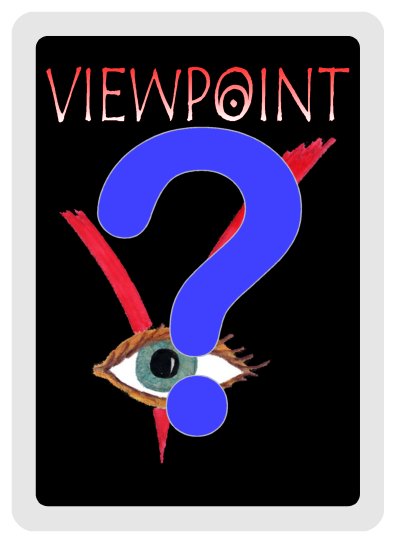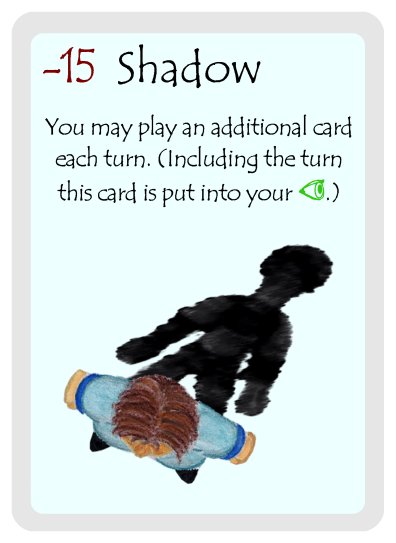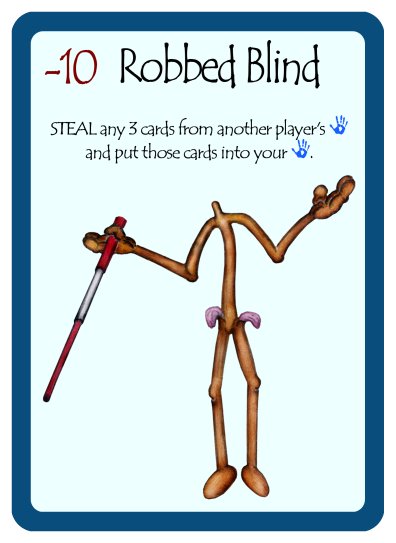|
This is a question that is commonly asked by those new to the game. Sometimes they are referring to the card with the best artwork or most enjoyable interaction but, in most cases, new players are referring to which card is the most powerful and most likely to win them the game. After a few games of Viewpoint, most players will tell you, “the most powerful Viewpoint card is definitely the Shadow card.” However, this assessment could be seen as subjective and begs the question, “Is it possible to calculate how powerful each Viewpoint card is?” The answer is yes, of course. But first we need to establish the criteria for calculating each card's power. To determine the power level of each card with fairness, all cards need to be assessed as if they were being played with together. This means that the assessment needs to be based on both Viewpoint decks being combined together with three copies of each of the special prize cards. Criteria consideration 1: All cards are to be compared when played with every other card in the standard quantities. To calculate the power rating of each card, we need to set out the assessment criteria. This criteria needs to be based on what cards do to get a player closer to the objective of reaching 100 View-points. In general, cards that allow you to play extra cards are more powerful than cards that let you draw extra cards. However, the cards which provide additional card plays are usually worth fewer View-points than those that allow you to draw more cards. Therefore, ratings need to be based on a combination of a card's actions, the power of the actions and its View-points. Criteria consideration 2: Ratings need to be established for actions and their power and for View-points. To improve the commonality between the criteria to assess the power of the actions, some actions can be broken down into sub-actions. For example, the STEAL action includes two sub-actions. 1. Removing a card from another player's Hand. 2. Adding a card to your Hand. Whereas, the DRAW action only has one sub-action. 1. Adding a card to your Hand. Therefore, the STEAL action is typically stronger than the DRAW action. Criteria consideration 3: Ratings need to be established for sub-actions as well as actions. The actions on some cards affect multiple targets or allow a player to perform those actions multiple times. A simple example is when the Wink card is compared to the Blink card. The former adds 1 card to your Hand whilst the latter adds 2 cards to your Hand. Obviously the Blink action is more powerful than the Wink action. Criteria consideration 4: Ratings need to be multiplied by the number of actions they allow or targets they affect (aka the weighting factor). Some actions are variable or depend on the number of players in the game. In these cases, an average or standard value can be used. For this assessment, the following “average” values will be used: 4 players per game; 2 cards of a specific name on the table at any one time (i.e. for Telescopic View); a multi-play/multi-draw/multi-protect card can be used 3 times for every time it is played; and for exchanging Hands, you have 1 card in your Hand and the opposing player has 5 cards in their Hand. Criteria consideration 5: “Average” weightings are used when the number of actions/targets/players is variable or undefined. Many actions can be cancelled by certain cards when a condition is met. e.g. Blind Spot can be cancelled by Spectacles. Therefore, the more likely that a card can be cancelled then the less powerful it is. Criteria consideration 6: Negative factors need to be applied to the ratings for cards that can be cancelled conditionally. Whilst most cards only affect one player, some cards can affect one or more players, including yourself. Depending on the specific targets, some cards will be more powerful than others. For example, Blind Freddie card make one player discard 3 cards, whereas Wild-eyed could make 3 other players discard 1 card each. It is usually better to cripple one player's Hand than it is to cause a minor nuisance to 3 other players. Furthermore, since multiplayer games of Viewpoint can be rather political in nature, it can be prudent to not annoy a whole group of players. Therefore, ratings need to be based on what targets/affects are allowed by the cards, when they can affect multiples. Criteria consideration 7: Ratings need to be based on the specific targets/affects and number of targets/affects that are allowed by certain actions. Not every similar action is equal. That is, some actions will be stronger or weaker, depending on the game state. This is typically exemplified by the under-powered play of playing The Triclops to draw 3 cards when the Draw Pile is empty. Another example is the difference between Evil Eye and Skewed View. Both allow you to remove cards from a player's Field of View but Skewed View will always allow you to remove 2 cards, whereas Evil Eye will only allow you to remove 2 cards if there are 2 cards with the same name in a player's Field of View. Therefore, bias needs to be considered when applying weighting factors. Criteria consideration 8: Weightings can be affected by certain bias factors. There are a few actions that don't fit within the standards of drawing and playing cards or have miscellaneous or additional affects, such as being able to cancel cards. These actions need to be given ratings that are commensurate with their overall ability to get a player to 100 View-points. Criteria consideration 9: Atypical actions need to have ratings that are commensurate with their abilities. Whilst the cards themselves are two-dimensional, their abilities are not and all ratings, weightings and other factors need to be combined to provide an overall card power rating. This power rating is then used to rank each card in their order of power level. Criteria consideration 10: Overall card power ratings need to be calculated to rank cards in their order of power level. Using the ten considerations in determining the criteria to employ when determining power level, the following criteria have been applied to determine power level ratings and rankings below. Adding a card to your Field of View (you choose the card) [+1] Adding a card to your Field of View (card chosen randomly) [+0.75] Adding a card to another player's Field of View (you choose the card) [-0.5] Removing a card from your Field of View (you choose the card) [-0.5] Removing a card from another player's Field of View (you choose the card) [+0.75] Adding a card to your Hand (search & pick or you choose the card) [+0.4] Adding a card to your Hand (you draw) [+0.2] Adding a card to your Hand (exchange or another player chooses) [+0.1] Adding a card to another player's Hand (you choose the card) [-0.1] Adding a card to another player's Hand (exchange or another player draws) [-0.2] Removing a card from your Hand (exchange or you choose the card) [-0.1] Removing a card from another player's Hand (you choose the card) [+0.4] Removing a card from another player's Hand (exchange or another player chooses) [+0.2] Copy a Card [+1] Hide/Protect a Card [+0.5] “Bonus” Reveal Ability [+0.5] Conditional Cancel [-0.25] 20 points [+0.8] 15 points [+0.65] 10 points [+0.5] 5 points [+0.25] 0 points [0] -5 points [-0.25] -10 points [-0.5] -15 points [-0.65] Viewpoint cards ranked in order of power with their power level ratings (in square brackets):
Using the criteria above, the most powerful Viewpoint card is indeed Shadow followed by See Into The Future and Robbed Blind. So next time you're thinking of which card to play or STEAL then consider one of these cards. But remember, some cards are stronger or weaker depending on the game state so you don't want to play Shadow when you're on 35 View-points and your opponent is on 95 View-points, unless you are certain you can win that turn. If you have any comments on the criteria or disagree with the results then please feel free to contact our designers. Want to give your opinion on Viewpoint and Viewpoint Reflections on a large forum? Then go to BoardGameGeek and rate and comment on the Viewpoint and Viewpoint Reflections card games.
0 Comments
Leave a Reply. |
Indie Games UnitedIndie Games United is a retailer and advocate of independently designed and published tabletop games. We collaborate with designers and publishers to provide gamers with unique, high quality and novel games. Archives
May 2023
Categories
All
|





 RSS Feed
RSS Feed